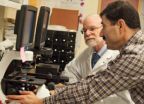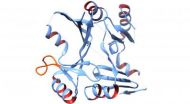(Press-News.org) With a little practice on a computer or iPad—25 minutes a day, 4 days a week, for 2 months—our brains can learn to see better, according to a study of University of California, Riverside baseball players reported in the Cell Press journal Current Biology on February 17. The new evidence also shows that a visual training program can sometimes make the difference between winning and losing.
The study is the first, as far as the researchers know, to show that perceptual learning can produce improvements in vision in normally seeing individuals.
"The demonstration that seven players reached 20/7.5 acuity—the ability to read text at three times the distance of a normal observer—is dramatic and required players to stand forty feet back from the eye chart in order to get a measurement of their vision," says Aaron Seitz of the University of California, Riverside. For reference, 20/20 is considered normal visual acuity.
In the training game, the players' task was to find and select visual patterns modeled after stimuli to which neurons in the early visual cortex of the brain respond best, Seitz explains. As game play commenced, those patterns were made dimmer and dimmer, exercising the players' vision as they searched.
"The goal of the program is to train the brain to better respond to the inputs that it gets from the eye," Seitz says. "As with most other aspects of our function, our potential is greater than our normative level of performance. When we go to the gym and exercise, we are able to increase our physical fitness; it's the same thing with the brain. By exercising our mental processes we can promote our mental fitness."
After the 2 month training period, players reported "seeing the ball much better," "greater peripheral vision," "easy to see further," "able to distinguish lower-contrasting things," "eyes feel stronger, they don't get tired as much," and so on.
The players also showed greater-than-expected improvements in their game. They were less likely to strike out and got more runs. The researchers estimate that those gains in batting statistics may have given the team an additional four or five wins in the 2013 season.
The researchers are now extending their work to include different groups, including members of the Los Angeles and Riverside Police Departments and people with low vision due to cataracts, macular degeneration, or amblyopia. They will also apply the same principles to other aspects of cognition, including memory and attention.
It all comes down to one thing: "Understanding the rules of brain plasticity unlocks great potential for improvement of health and wellbeing," Seitz says.
INFORMATION:
Current Biology, Deveau et al.: "Improved vision and on field performance in baseball through perceptual learning."
Learning to see better in life and baseball
2014-02-17
ELSE PRESS RELEASES FROM THIS DATE:
Outsmarting nature during disasters
2014-02-17
The dramatic images of natural disasters in recent years, including hurricanes Katrina and Sandy and the Tohoku, Japan, earthquake and tsunami, show that nature, not the people preparing for hazards, often wins the high-stakes game of chance.
"We're playing a high-stakes game against nature without thinking about what we're doing," geophysicist Seth Stein of Northwestern University said. "We're mostly winging it instead of carefully thinking through the costs and benefits of different strategies. Sometimes we overprepare, and sometimes we underprepare."
Stein will ...
Zoonotic diseases and global viral pandemics
2014-02-17
Emergence of new microbes
While many endemic infectious diseases of humans have been largely contained, new microbes continue to emerge to threaten human and animal health. Such emerging infectious diseases are not confined to humans and their livestock but extend to wildlife ecosystems; the finely-tuned dynamic balance of which is destabilised by human interventions. The changes in the scale and manner of livestock production and marketing, the increase of global travel and trade including the trade in domestic livestock as well as the pet animal trade, the increasing ...
JCI early table of contents for Feb. 17, 2014
2014-02-17
Neurotensin conjugate provides pain relief in animal models
The small peptide neurotensin is a potent regulator of dopamine signaling and can provide dramatic pain relief; however, the blood brain barrier provides a substantial challenge toward clinical use of neurotensin for analgesia. In this issue of the Journal of Clinical Investigation, Philippe Sarret and colleagues at Université de Sherbrooke generated a conjugate of neurotensin with a peptide able to cross the blood brain barrier and evaluated the analgesic effects of this molecule in animal models of pain. The ...
Extensive renewal of the T cell repertoire following autologous stem cell transplant in MS
2014-02-17
WA, Seattle (February 17, 2014) – A new study describes the complexity of the new T cell repertoire following immune-depleting therapy to treat multiple sclerosis, improving our understanding of immune tolerance and clinical outcomes.
In the Immune Tolerance Network's (ITN) HALT-MS study, 24 patients with relapsing, remitting multiple sclerosis received high-dose immunosuppression followed by a transplant of their own stem cells, called an autologous stem cell transplant, to potentially reprogram the immune system so that it stops attacking the brain and spinal cord. ...
Finding common ground fosters understanding of climate change
2014-02-17
EAST LANSING, Mich. — Grasping the concept of climate change and its impact on the environment can be difficult. Establishing common ground and using models, however, can break down barriers and present the concept in an easily understood manner.
In a presentation at this year's meeting of the American Association for the Advancement of Science, Michigan State University systems ecologist and modeler Laura Schmitt-Olabisi shows how system dynamics models effectively communicate the challenges and implications of climate change.
"In order to face the ongoing challenges ...
Small non-coding RNAs could be warning signs of cancer
2014-02-17
Small non-coding RNAs can be used to predict if individuals have breast cancer conclude researchers who contribute to The Cancer Genome Atlas project. The results, which are published in EMBO reports, indicate that differences in the levels of specific types of non-coding RNAs can be used to distinguish between cancerous and non-cancerous tissues. These RNAs can also be used to classify cancer patients into subgroups of individuals that have different survival outcomes.
Small non-coding RNAs are RNA molecules that do not give rise to proteins but which may have other ...
New finding points to potential options for attacking stem cells in triple-negative breast cancer
2014-02-17
ANN ARBOR, Mich. — New research from the University of Michigan Comprehensive Cancer Center and Georgia Regents University finds that a protein that fuels an inflammatory pathway does not turn off in breast cancer, resulting in an increase in cancer stem cells. This provides a potential target for treating triple negative breast cancer, the most aggressive form of the disease.
The researchers identified a protein, SOCS3, that is highly expressed in normal cells but undetectable in triple-negative breast cancer. They showed that this protein is degraded in cancers, blocking ...
Religious and scientific communities may be less combative than commonly portrayed
2014-02-17
One of the largest surveys of American views on religion and science suggests that the religious and scientific communities may be less combative than is commonly portrayed in the media and in politics.
Only 27 percent of those surveyed said that they viewed science and religion as being in conflict with each other, with about equal percentages of those people "siding with either religion or science," said Rice University sociologist Elaine Howard Ecklund at the AAAS Annual Meeting. The survey was commissioned by the AAAS Dialogue on Science, Ethics and Religion (DoSER) ...
Uncovering the secrets of tularemia, the 'rabbit fever'
2014-02-17
WASHINGTON D.C. Feb. 16, 2014 -- Tularemia, aka "rabbit fever," is endemic in the northeastern United States, and is considered to be a significant risk to biosecurity -- much like anthrax or smallpox -- because it has already been weaponized in various regions of the world.
At the 58th Annual Biophysical Society Meeting, which takes place Feb. 15-19, 2014, in San Francisco, Calif., Geoffrey K. Feld, a Postdoctoral researcher in the Physical & Life Sciences Directorate at Lawrence Livermore National Laboratory (LLNL), will describe his work to uncover the secrets of the ...
Bacterial superbug protein structure solved
2014-02-17
WASHINGTON D.C. Feb. 16, 2014 -- A research team from Vanderbilt University Medical Center in Nashville, Tenn., is the first to decipher the 3-D structure of a protein that confers antibiotic resistance from one of the most worrisome disease agents: a strain of bacteria called methicillin-resistant Staphylococcus aureus (MRSA), which can cause skin and other infections. The Vanderbilt team's findings may be an important step in combatting the MRSA public health threat over the next 5 to 10 years.
By deciphering the shape of a key S. aureus protein -- an enzyme called ...


